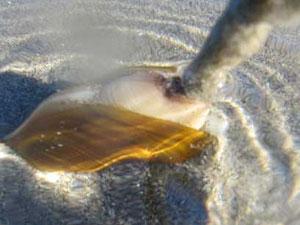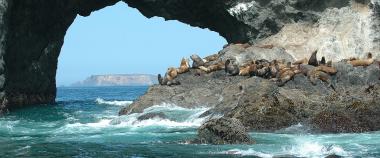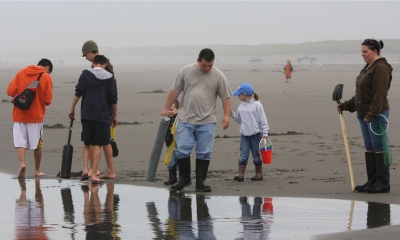
Southwest Zone
The southwest zone includes Umpqua River, Coos Bay, Coquille River, Port Orford, Rogue River and Chetco River - all of which offer shellfishing.

For your safety, call the Oregon Department of Agriculture Shellfish Safety Hotline before harvesting any shellfish at 1-800-448-2474 or check their website.
Regulation Highlights
Please check the sport fishing e-regulations Marine Zone for all the shellfishing limits and laws.
Razor clams
- Daily limit of first 15 dug (no sorting or releasing).
- Razor clams may be taken by hand, shovel, clam gun or tube with opening no less than 4” (cylindrical) or 4” X 3” (elliptical).
- Razor clams are closed July 15 to Sept. 30 north of Tillamook Head (Clatsop County) for annual conservation closure.
- Before heading out, always check the weekly Recreation Report to see which areas of the coast are currently open or closed for razor clamming.
Bay clams (butter, littleneck, gaper, and cockle)
- Daily limit of 20 in aggregate, only 12 may be gapers.
- Must take first 12 gapers (no sorting or releasing).
- May be taken by hand or hand-powered tools.
Purple varnish clams
- Daily limit of 72.
Other Clams (softshell, piddocks and others not listed)
- Daily limit of 36 in aggregate.
- Must take first 36 softshells (no sorting or releasing).
Dungeness crab
- Daily limit of 12 (males only).
- Minimum size of 5 ¾ inches. Correct size is measured as a straight line across the back (caliper measurement) in front of, but not including the points.
- Bays, beaches, estuaries, tide pools, piers and jetties are open for crabbing all year, 24 hours per day.
- Ocean waters are closed for crab Oct. 16 – Nov. 30.
- May be taken using crab rings, baited lines, or pots (limited to 3 rings/lines/pots total, per person); by hand, dip net, or rake.
Red rock crab
- Daily limit of 24 of any size or sex.
- May be taken using crab rings, baited lines, or pots (limited to 3 rings/lines/pots total, per person); by hand, dip net, or rake.
- Bays, beaches, estuaries, tide pools, piers and jetties are open for crabbing all year, 24 hours per day.
- Ocean waters are closed for crab Oct 16-Nov 30.
European green crab
- Daily limit of 35 of any size or sex.
- Bay, beaches, estuaries, tide pools, piers and jetties are open for crabbing all year, 24 hours per day.
- Ocean waters are closed for crab Oct 16-Nov 30.
- May be taken using crab rings, baited lines, or pots (limited to 3 rings/lines/pots total, per person); by hand, dip net, or rake.
- Identified by five spines on the outside of each eye, with three bumps between the eyes.
Crabbing in the Southwest Zone
You can crab by boat, dock, or shore in the southwest zone. There are areas in several bays to drop a crab pot, ring, or baited line and pull up Dungeness or red rock crab.
Razor clamming in the Southwest Zone
Razor clams are found throughout Oregon’s ocean beaches. Though they are primarily found in the northwest zone, they can be found on the shores of Whiskey Run (Coos), Bailey Beach (Gold Beach), Myers Creek (Gold Beach), and others.
Bay clamming in the Southwest Zone
Oregon estuaries are rich with many species of clams, although only a few of these species are commonly harvested. Gaper, butter, cockle, littleneck, and softshell are primarily harvested due to their abundance, size, and taste.
Coos Bay: Oregon’s largest bay. The lower bay (areas from the ocean entrance to the airport) is “marine dominated”, meaning there is little freshwater influence, and offers some of Oregon’s most productive shellfishing opportunities.
- All species of “bay clams” are found in abundance in lower Coos Bay where the tideflats are large and easily accessible.
- In upper Coos Bay where marine influence and salinity is lower, softshell clams are found on soft muddy flats.
- Shore crabbing is worthwhile year-round, though best during fall and winter. Dock crabbing access points are found in Empire and Charleston.
- Boat crabbing is excellent, particularly west of the navigational channel in lower Coos Bay.
Coquille River: The areas around Bandon, on the Coquille River, have productive softshell beds. The areas near Bandon Marsh, National Wildlife refuge tend to be the most popular. Populations of other bay clams may be found close to the jetties but are mostly subtidal.
- Softshell clams are abundant and easily dug in the lower bay. Finding firm ground to walk on can be challenging.
- Dungeness crabbing in the summer to early winter is very good. Dock crabbing at the boat ramp docks can be among the best in the state. Crabbing here tends to be hot and cold so recent reports are valuable.
- Boat crabbing is seasonally excellent west of the Hwy 101 bridge. Be wary of navigational channel when setting gear.
Umpqua River: Umpqua River is one of Oregon's largest estuaries, however, high freshwater influence makes the bay seasonal for crabbing. Softshell clam populations in the Umpqua river are among the highest in the state and they are big clams.
- Razor clams can be dug at the North Jetty of the Umpqua, though it's a long drive down Sparrow Park Rd. (just north of Gardiner), then South along the beach around 8 miles.
- Softshell clams are abundant throughout Umpqua Bay, also they tend to be very large in size compared to other bays. Most of Umpqua's clam beds can be accessed by only boat. An easy access bed is near Bolin Island near the Hwy 101 bridge between Reedsport and Gardner.
- Shoreside crabbing is available from the public crabbing dock near Winchester Bay.
- Dungeness crabbing in the summer to early winter can be good. Good areas tend to be limited to the first two miles of the river. "Half Moon Bay" is a great place to set gear away from the current.
Port Orford: The oldest town on the Oregon coast and the most westerly in the 48 states.
- Dock crabbing can be found year-round from the Port docks. Ocean (boat) crabbing areas are easily accessible.
Gold Beach (Rouge River) and Brookings (Chetco River): Crabbing in these estuaries may only be successful in the driest parts of the summer when the freshwater influence is minimal. Ocean (boat) crabbing areas are easily accessible.
- Dungeness crab, razor clams, and butter clams can all be found along the coastline of Gold Beach.
- There is a population of razor clams on Bailey Beach.
- Find butter clams at Rocky Point.




